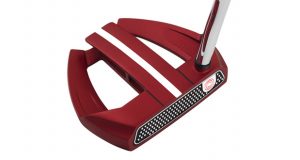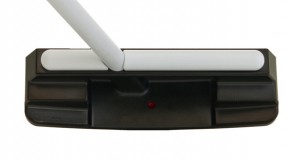If you thought that Odyssey Golf was going to rest on the laurels of its wildly successful White Hot 2-Ball putter, think again. Two years ago, at the height of the 2-Ball’s popularity, Odyssey was already plotting its path to the next level. That effort ultimately included last year’s unveiling of the company’s new White Hot XG insert technology, followed by the launch of the innovative Black Series putters earlier this year. Perhaps the most notable of Odyssey’s new releases is the Marxman, whose striking alignment features are being billed by Odyssey as the successor to the pioneering alignment attributes of the 2-Ball putter. Earlier this week, PutterZone.com spoke with Rob Arluna, Director of Brand Management at Odyssey, to get the inside scoop on the company’s latest products and achievements. Following is the transcript of our exclusive interview:
Odyssey Golf is having a good year. Can you tell us more about your recent successes, starting with the retail experience?
How about on tour?
On tour we’re having a great year. We’ve increased Odyssey putter usage across pretty much every single tour, certainly across the six major professional tours around the world. On the PGA Tour, year-to-date last year we were at 16.4 percent usage, and we’re now up to 20.5 percent (editor’s note: this means that 20.5 percent of all PGA Tour players are using Odyssey putters). On the Champion’s Tour, we’re number one in usage at 38.7 percent. On the LPGA Tour we’re number one at 30.7 percent. On the Nationwide Tour, we’re number two at 22.6 percent. On the European Tour, we’re number one at 43 percent. And on the Japan Tour we have 67 percent usage, which is a pretty amazing statistic. So across those six major tours, we’re number one in usage, and on every single tour, with the exception of the European Tour, we’ve seen growth over last year.
What is different about your newer White Hot XG technology compared to your original White Hot series, specifically in terms of features and benefits?
The insert in the original White Hot was a one-piece urethane-based material. And the beauty of it, and the reason it took the company to the next level, is because generally when you make a putter softer, you lose some resiliency. But we found with this urethane-based material, the softer we made it, the more resilient the putter was, so the ball was coming off and feeling responsive, and traveling the distance people wanted it to. Also, the cover material was virtually identical to the cover material of the original (Callaway Golf) Rule 35 golf ball, so it interacted very well with the ball. And I think that people, for the first time, were feeling a soft putter that actually had responsiveness, and the feel and sound that they liked. So that’s why White Hot was originally such a success.
It was a challenging request to the R&D department to try to replace White Hot with a new form of White Hot that was better. What we did was move to a multi-material construction. While the original White Hot was the one-piece urethane based insert, the new construction is multi-material, meaning that there’s a core material, similar to the core of a golf ball, and then a cover material. This gave us the ability to work with two different materials to de-couple sound and de-couple feel, so that the responsive material, the core material in the back, is soft and resilient, while the cover material provides the flexibility to fine tune sound, which is a big part of feel. So now in the White Hot XG we have a putter where the sound is really good, the feel is really good, and we have the flexibility to tweak those two materials to get exactly the type of responsiveness that we want. It’s just a bit more technological.
You still make a White Hot XG 2-Ball putter, the design for which Odyssey is best known, as well as several other White Hot XG models. Yet most of your current White Hot XG marketing efforts center around the White Hot XG Marxman model. Why is that?
The White Hot XG 2-Ball replaced the original White Hot 2-Ball, and that came into the market last August, so it’s been in the market less than a year. And we came out this year with the Marxman in April. Marxman for us is really a complement to the 2-Ball line. Marxman is our flagship model this year, it’s our newest technology. Our feeling on that was, we really launched the alignment craze back in 2002 when we offered the 2-Ball, and we hadn’t really had another innovative alignment device since then.
We sold more than three million 2-Balls worldwide, and we took a step back and said, ”Okay, how can we complement the 2-Ball putter line?” So we worked with a bunch of alignment technologies, and we took them out to both the tour and consumers, and landed on this Marxman technology, which is basically two straight parallel lines on top of the putter versus the circular alignment feature of the 2-Ball. So we’re finding that you may either be a 2-Ball guy or gal, or you may be a Marxman guy or gal. If you like to visualize the line in terms of grids, you might like the Marxman. If you’re a little more conceptual, you might like the 2-Ball. It’s what fits your eye. That’s the reason we introduced the Marxman, it’s the newest and latest and greatest from us, and I think people are familiar with the 2-Ball at this point.
You launched a new line of Black Series putters in February. Can you tell us more about these putters, and what sets them apart from the competition?
We’ve been known as an insert putter company. That’s what got the company off the ground, and until now we’ve only made insert putters, which is basically a softer material on the face as opposed to a milled metal face. As I said earlier, we started managing the brand a little more tightly, and taking a look at how we could ensure that we had a putter for all golfers that provides a technological advantage. One of the places that we didn’t have an offering was at the high end with a milled metal non-insert putter. There are definitely golfers out there who prefer the feel of metal and who prefer an all-milled putter, and we hadn’t really offered that.
So we took a look at the marketplace, and we felt that there was an opportunity for us to get into that segment, and to do it by providing a technological advantage. So the Black Series is a line of putters—one mallet and two different blades—that were tested heavily on tour, and that are tour-proven. They’re made out of carbon steel, which is a soft-feeling steel. They’re 100 percent CNC milled. And generally, that’s where other companies will stop. They’ll mill a piece of carbon steel into a really nice shape and provide that to the consumer.
But we added a tungsten flange to the back of the putters. Tungsten is heavier than carbon steel, so that moves the center of gravity lower and deeper. A lower center of gravity ultimately provides a truer and better roll. Then, between the tungsten flange and the carbon steel, is a urethane dampening layer so that you don’t get any vibrations between the two metals. So we’ve entered the marketplace at the high end, for the players who play a lot of golf. These are putters that set up with a very traditional look, which is what that avid player likes to look at, yet they also provide a distinct technological advantage.
Thank you, Rob. For more information, visit www.odysseygolf.com.
 PutterZone – Best Putter Reviews
PutterZone – Best Putter Reviews



